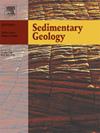巴西Parnaíba盆地上侏罗统湖相旋回的高分辨率层序地层学:通过气候和热沉降揭示盆地演化
IF 2.9
2区 地球科学
Q1 GEOLOGY
引用次数: 0
摘要
西冈瓦纳晚侏罗世古湖泊是在201 Ma前后与中大西洋岩浆省(CAMP)相关的均衡调整、等温线降级和基性岩浆冷却的驱动下,由热沉降形成的。这些关键过程记录在巴西东北部Parnaíba盆地内的Pastos Bons组中。虽然最近从古环境的角度对这一沉积演序进行了研究,但在通过高分辨率层序地层学(HRSS)来表征其堆积模式方面仍有很大的空白。因此,气候和热沉降之间的相互作用及其对沉积和湖泊水位波动的影响仍然缺乏明确的认识。因此,我们确定了20个沉积相,并将其分为6个相组:中央湖(FA1)、海陆三角洲(FA2)、湖滨(FA3)、冲积扇(FA4)、河流(FA5)和三角洲前缘(FA6)。HRSS框架揭示了三个中频序列,代表了受长期气候变化控制的高频T-R序列簇:序列-1 (Seq-1)、序列-2 (Seq-2)和序列-3 (Seq-3)。Seq-1和Seq-2的海侵体系域(TST)比例高于海侵体系域(RST),且湖平面波动剧烈。而Seq-3则表现为回归体系域(RST)优于海侵体系域(TST),反映了湖平面的稳定性。中频格架显示,帕斯托斯-邦斯组为平衡充填湖盆(Seq-1和Seq-2)和过充填湖盆(Seq-3)的叠加。由中频T-R层序组成的低频年代地层格架(地震尺度)表明,camp后热沉降对湖盆的形态、大小、形状和容纳潜力起主要控制作用。晚侏罗世赤道大西洋边缘后camp沉降对西冈瓦纳古地理的形成起了关键作用,促进了湖相盆地的发育。本文章由计算机程序翻译,如有差异,请以英文原文为准。
High-resolution sequence stratigraphy of Upper Jurassic lacustrine cycles in the Parnaíba Basin, Brazil: Unraveling basin evolution through climate and thermal subsidence
Palaeolakes of the Late Jurassic, in West Gondwana, were critically shaped by thermal subsidence, driven by isostatic adjustment, isotherm downgrading, and the cooling of mafic magma associated with the Central Atlantic Magmatic Province (CAMP) around 201 Ma. These key processes are recorded in the Pastos Bons Formation, located within the Parnaíba Basin in northeastern Brazil. Although this sedimentary succession has recently been examined from a palaeoenvironmental perspective, a significant gap remains in characterizing its stacking patterns through the lens of high-resolution sequence stratigraphy (HRSS). Therefore, there remains a lack of clarity regarding the interplay between climatic and thermal subsidence and its influence on sedimentation and lake level fluctuations. Hence, we identified twenty sedimentary facies, grouped into six facies associations: central lake (FA1), hyperpycnal littoral delta (FA2), lakeshore (FA3), alluvial fan (FA4), fluvial (FA5), and delta front (FA6). The HRSS framework reveals three medium-frequency sequences, representing clusters of high-frequency T-R (transgressive-regressive) sequences, controlled by long-term climatic changes: sequence-1 (Seq-1), sequence-2 (Seq-2), and sequence-3 (Seq-3). Seq-1 and Seq-2 exhibit a higher proportion of transgressive system tract (TST) than regressive system tract (RST), and they demonstrate dramatic fluctuations in lake level. In contrast, Seq-3 shows a predominance of the regressive systems tract (RST) over the transgressive systems tract (TST), reflecting greater stability in lake level. The medium-frequency framework reveals that the Pastos Bons Formation is characterized by a balanced-fill lacustrine basin (Seq-1 and Seq-2) overlaid by an overfilled lacustrine basin (Seq-3). The low-frequency chronostratigraphic framework, composed of clusters of medium-frequency T-R sequences (seismic scale), indicates that post-CAMP thermal subsidence presents a primary control on the configuration, size, shape, and accommodation potential of the lacustrine basin. Post-CAMP subsidence along the Equatorial Atlantic margins during the Late Jurassic period played a key role in shaping the palaeogeography of West Gondwana, promoting the development of lacustrine basins.
求助全文
通过发布文献求助,成功后即可免费获取论文全文。
去求助
来源期刊

Sedimentary Geology
地学-地质学
CiteScore
5.10
自引率
7.10%
发文量
133
审稿时长
32 days
期刊介绍:
Sedimentary Geology is a journal that rapidly publishes high quality, original research and review papers that cover all aspects of sediments and sedimentary rocks at all spatial and temporal scales. Submitted papers must make a significant contribution to the field of study and must place the research in a broad context, so that it is of interest to the diverse, international readership of the journal. Papers that are largely descriptive in nature, of limited scope or local geographical significance, or based on limited data will not be considered for publication.
 求助内容:
求助内容: 应助结果提醒方式:
应助结果提醒方式:


